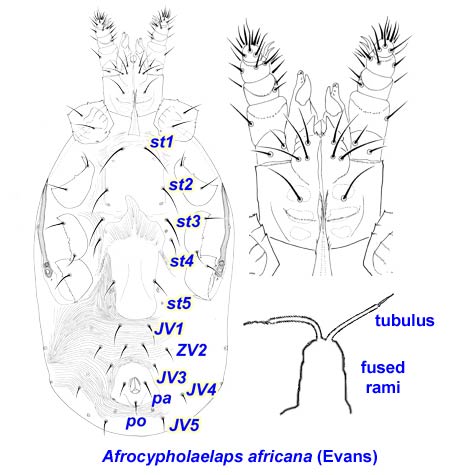
Home | Mesostigmata (Monogynaspida) Home | Glossary
Afrocypholaelaps
Taxonomic Position
Cohort Gamasina
Subcohort Dermanyssiae
Superfamily Ascoidea
Diagnostic characters:
Dorsal shield lightly sclerotized and with 29 pairs of setae, setae J5 absent
Sternal shield reduced and bearing 2 pairs of setae
Corniculi simple or bifurcate
Chelicerae tong-like, with membranous lobe
Tectum simple, smoothly triangular
Genu III with 8 setae (1-2/1,2/1-1), tibia III with 7 setae (1-1/1,2/1-1)
Pretarsi with large membranous pad and claws.

Similar taxa. The most reliable character for the Ameroseiidae is the lack of setae J5 on the posterior dorsal shield. However, among the taxa with toothed or bifurcate corniculi, ameroseiids are likely to be commonly confused only with species of Proctolaelaps, which occur in similar habitats, but Proctolaelaps have numerous dorsal shield setae (including most of the r-R rows) and a ventral mucro on the chelicerae; rami of spermatheca fused. Species of Hattena and Neocypholaelaps also live in flowers, eat pollen and nectar, and use birds or insects for transport and can be differentiated in the key below.
Key to Flower-inhabiting Ameroseiidae (females)
1. Dorsal setae in s- & r-series setae leaf-like and biserrate...Neocypholaelaps stridulans group
- Dorsal setae acicular, simple or weakly barbed..................................................................2
2. Pretarsi with distinct claws; often some dorsal shield setae thickened & barbed...Neocypholaelaps
- Pretarsi without distinct claws, only pad-like pulvillus; dorsal shield setae fine, simple.......3
3. Dorsal shield with 29 pairs of setae; ducts fused above spermatheca...............................Afrocypholaelaps
- Dorsal shield with 25 or fewer pairs of setae; ducts separate............................................Hattena
Ecology & Distribution. Species of Afrocypholaelaps inhabit flowers and feed on pollen and nectar. They are phoretic on flower-visiting insects, including honeybees and lepidopterans. A. africana is known from Africa, Australia and Papua New Guinea; A. lindquisti (Prasad) from a noctuid moth in Hawaii; A. ranomafanaensis Haitlinger from a butterfly in Madagascar.
References
Domrow, R. 1963. New records and species of Austromalayan laelapid mites. Proceedings of the Linnean Society of New South Wales 88 : 199-220.
Domrow, R. 1966. Some mite parasites of Australian birds. Proceedings of the Linnean Society of New South Wales 90 : 190-217.
Domrow, R. 1979c. Ascid and ameroseiid mites phoretic on Australian mammals and birds. Records of the Western Australian Museum 8 : 97-116.
Elsen, P. 1972. Afrocypholaelaps gen. nov., un nouveau genre pour Neocypholaelaps africana Evans, 1963, et redescription de cette espèce (Acari : Mesostigmata). Revue de Zoologie et de Botanique Africaines 86 : 158-162.
Evans GO. 1963. The genus Neocypholaelaps Vitzthum (Acari : Mesostigmata). Annals and Magazine of Natural History (13th series) 6: 209-230.
Halliday RB. 1997. Revision of the Australian Ameroseiidae (Acarina: Mesostigmata). Invertebrate Taxonomy 10: 179-201.
Seeman OD. 1996. Flower mites and phoresy: The biology of Hattena panopla Domrow and Hattena cometis Domrow (Acari: Mesostigmata: Ameroseiidae). Aust J Zool 44: 193-203.
Seeman OD, Walter DE. 1995. Life history of Afrocypholaelaps africana (Evans) (Parasitiformes: Ameroseiidae), a mite inhabiting mangrove flowers and phoretic on honeybees. Journal of the Australian Entomological Society 34: 45-50.